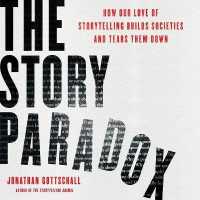Full Description
A concise guide to the creative application of appropriation and remix that offers a set of open-ended guidelines for art and design studio-based projects, this book explores creativity with emerging technology, including artificial intelligence.
This fully revised and expanded second edition engages with the ongoing recycling and repurposing of content and form, and the new directions the emerging form of metacreativity is taking art and design as artists continue to expand their creative methodologies. Exploration of metacreativity is new to this edition, with a focus on remix principles, the implementation of data analysis, and the delegation of parts of the creative process to automated algorithms and artificial intelligence. Each chapter includes an introduction, goals for guidelines of a studio-based project, with an explanation of relevant history, as well as examples and case studies. Each set of guidelines is open-ended, enabling the reader to repurpose the instructional material according to their own methodologies and choice of medium. Navas also provides historical and theoretical context to encourage critical reflection.
The second edition remains the first book of guidelines to take into account the historical, theoretical, and practical context of remix as an interdisciplinary act. This is an essential read for those interested in remix studies and appropriation in art, design, and media.
Contents
Acknowledgments
List of Figures
Introduction
General Remix Principles and Key Terms
Part 1: Media Production
Chapter 1: Randomized Signification - Elements for Exchange
Chapter 2: Analogized Codification - Mashups of Image and Text
Chapter 3: Sampling Creativity - Material Sampling and Cultural Citation
Chapter 4: Vectorial Pixels - Visual Aesthetics of Binary Code
Chapter 5: Bifurcated Meaning - Infliction of Statements
Essay: Modernism and Media Production
Part 2: Metaproduction
Chapter 6: Domesticated Noise - Manipulation of Sound
Chapter 7: Visual Aurality - Image and Sound as Data
Chapter 8: Versioning Time-Based Media - Reedits of Video and Sound
Chapter 9: Time-Based Media in Physical Space - Loops in Video and Sound Installations
Chapter 10: The Assemblage Gaze - Of Media and Humans
Essay: Postmodernism and Metaproduction
Part 3: Postproduction
Chapter 11: Media Mashups - Appropriation and Remix of Image, Sound, and Text
Chapter 12: Regenerative Motion - Correlated Time Based Media
Chapter 13: Reflexive Mashups - Aesthetics of Data Driven Objects
Chapter 14: Distributed Collaboration - Collective Work Across Networks
Chapter 15: Aesthetics of Negation - The Negative Selective Process
Essay: The Prefix and Post Production
Part 4: Metacreativity
Chapter 16: Visual Analytics: Image Mining and Artificial Intelligence
Chapter 17: Textual Analytics: Text-Mining and Artificial Intelligence
Chapter 18: Sound Analytics: Sound-Mining and Automation
Chapter 19: Creative Prompts: Artificial Intelligence for Image and Text Production
Chapter 20: Automated Bifurcations: Artificial Intelligence and Media Production
Essay: Metacreativity and AI Aesthetics
Index








